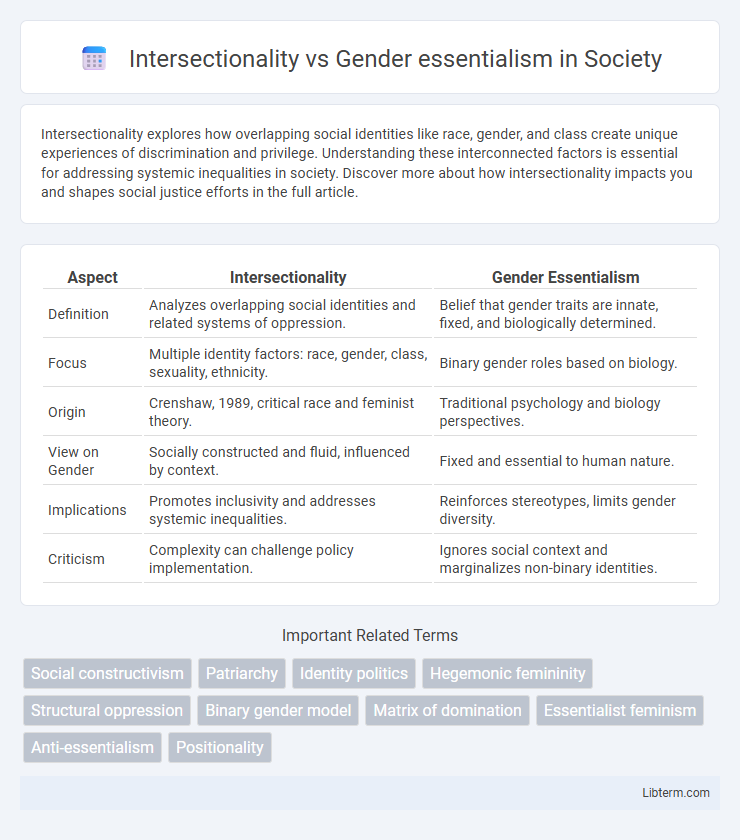Intersectionality explores how overlapping social identities like race, gender, and class create unique experiences of discrimination and privilege. Understanding these interconnected factors is essential for addressing systemic inequalities in society. Discover more about how intersectionality impacts you and shapes social justice efforts in the full article.
Table of Comparison
| Aspect | Intersectionality | Gender Essentialism |
|---|---|---|
| Definition | Analyzes overlapping social identities and related systems of oppression. | Belief that gender traits are innate, fixed, and biologically determined. |
| Focus | Multiple identity factors: race, gender, class, sexuality, ethnicity. | Binary gender roles based on biology. |
| Origin | Crenshaw, 1989, critical race and feminist theory. | Traditional psychology and biology perspectives. |
| View on Gender | Socially constructed and fluid, influenced by context. | Fixed and essential to human nature. |
| Implications | Promotes inclusivity and addresses systemic inequalities. | Reinforces stereotypes, limits gender diversity. |
| Criticism | Complexity can challenge policy implementation. | Ignores social context and marginalizes non-binary identities. |
Understanding Intersectionality: A Comprehensive Overview
Intersectionality examines how overlapping social identities such as race, gender, class, and sexuality create unique experiences of oppression and privilege, challenging gender essentialism's fixed perceptions of gender roles. This framework highlights the multidimensional nature of discrimination, emphasizing that gender cannot be understood in isolation from other identity categories. Understanding intersectionality is crucial for developing inclusive policies and social justice initiatives that address the complex realities faced by marginalized groups.
Gender Essentialism: Origins and Core Concepts
Gender essentialism asserts that gender differences are innate, biologically determined traits fixed across cultures and time. Its origins trace back to early Enlightenment thought and 19th-century biological sciences that emphasized dichotomous sex roles and evolutionary justifications for gender behavior. Core concepts include the belief in immutable male and female natures dictating social roles, contrasting sharply with intersectionality's focus on overlapping social identities and structural inequalities.
Historical Contexts Shaping Both Perspectives
Historical contexts reveal that intersectionality emerged from Black feminist thought in the late 20th century, challenging the limitations of gender essentialism by highlighting how race, class, and other identities intersect with gender. Gender essentialism, rooted in 19th and early 20th-century feminist and biological theories, emphasized fixed, universal traits assigned to women. The civil rights movement and critiques of second-wave feminism fueled the rise of intersectionality as a response to the narrow, essentialist views that excluded diverse experiences of oppression.
Intersectionality in Modern Gender Theory
Intersectionality in modern gender theory emphasizes the interconnectedness of social identities such as race, class, and sexuality, highlighting how overlapping systems of oppression shape individual experiences. This approach challenges gender essentialism, which assumes fixed, universal characteristics of gender, by recognizing diversity and complexity within gender identities. Intersectional analysis provides a critical framework for addressing inequalities in policy, activism, and academic research.
The Pitfalls of Gender Essentialism
Gender essentialism oversimplifies complex human identities by attributing fixed traits to men and women, ignoring the diverse experiences shaped by race, class, sexuality, and other social factors. This narrow perspective marginalizes individuals who do not conform to traditional gender norms and perpetuates systemic inequalities by erasing intersecting identities. Intersectionality highlights these multifaceted dimensions, providing a more inclusive framework that challenges binary gender assumptions and promotes social justice.
Case Studies: Real-World Impacts of Both Approaches
Case studies reveal that intersectionality offers a nuanced understanding of overlapping social identities, highlighting how race, class, and gender combine to shape unique experiences of discrimination, such as in workplace bias against women of color. In contrast, gender essentialism often overlooks this complexity, leading to policies that fail to address the specific needs of marginalized groups, as seen in gender wage gap interventions that assume uniform female experiences. Empirical evidence from these studies underscores intersectionality's efficacy in crafting inclusive social justice strategies that reflect the diverse realities of individuals.
Intersectionality vs Gender Essentialism in Policy Making
Intersectionality in policy making acknowledges the overlapping and interconnected nature of social identities such as race, gender, class, and sexuality, allowing for more inclusive and nuanced approaches that address multiple forms of discrimination simultaneously. Gender essentialism in policy making simplifies gender into fixed, binary categories, often ignoring the diverse experiences and systemic inequalities faced by marginalized groups. Policies grounded in intersectionality promote equity by recognizing how various social factors intersect to impact individuals differently, whereas essentialist policies risk perpetuating exclusion and reinforcing stereotypes.
Critics and Controversies Surrounding Each Perspective
Critics of intersectionality argue that it complicates social justice efforts by creating fragmented identity politics and risking victimhood hierarchies that obscure commonalities across groups. Gender essentialism faces controversy for promoting reductive stereotypes by assuming fixed, innate gender traits, thereby ignoring the fluidity and cultural construction of gender. Both perspectives face debates over their implications for feminist theory, policy-making, and efforts to address systemic inequality comprehensively.
Moving Beyond Binaries: Integrative Approaches
Moving beyond binaries in gender studies requires integrating intersectionality, which highlights the interconnectedness of race, class, and sexuality with gender, challenging singular identity frameworks. Intersectionality promotes understanding how overlapping social categories create unique experiences of oppression or privilege, contrasting with gender essentialism's fixed, biologically determined notions. Embracing integrative approaches enables more nuanced policies and social practices that reflect diverse identities and realities beyond simplistic male/female or masculine/feminine binaries.
Future Directions: Evolving Debates on Gender and Identity
Future directions in the debates on gender and identity emphasize integrating intersectionality to address complexities beyond fixed gender categories, challenging gender essentialism's simplistic binary views. Emerging frameworks advocate for a nuanced understanding that incorporates race, class, sexuality, and other social determinants, fostering more inclusive and dynamic identities. This evolution in scholarship and activism encourages policies and discourses recognizing fluid and multifaceted experiences of gender, shaping progressive social justice movements worldwide.
Intersectionality Infographic

 libterm.com
libterm.com